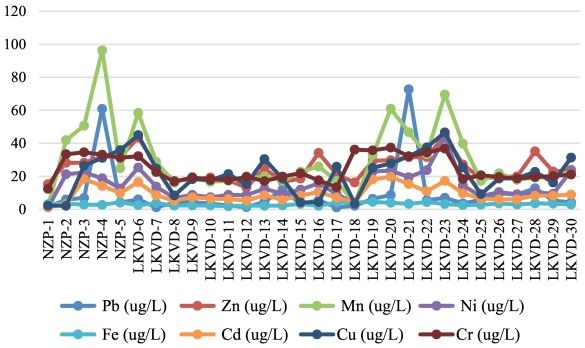
In recent years, the impact of the wastes discharged in the Bay of Bengal has been significant due to high effluent inflow from secured sources. It was observed that the heavy metal concentrations in the Bay coast sediments were considerately high and varied among sampling points.
Heavy metal contamination of the marine ecosystem has become a worldwide problem in recent years. Toxic heavy metal pollutants are produced directly from atmospheric deposition, geologic weathering, or industrial waste effluents. Because of their possible toxicity and capacity to bioaccumulation in marine environments, research into the degree and distribution of contamination of heavy metals in the fragile coastal region has recently piqued the public interest.
Metals such as cadmium (Cd), Chromium (Cr), Nickel (Ni), and Lead (Pb) are often regarded as markers of anthropogenic influence in the marine environment as a whole, as well as a possible danger to the natural environment.
Due to high heavy metal emission, several researchers have demonstrated the importance of evaluating metal distribution in marine surface sediment. As a result, assessing and evaluating these heavy metals in the coastal environment is a critical challenge, particularly in areas where pollution levels are troubling, such as when local factories discharge untreated wastewater directly into the sea, causing significant harm to marine ecology and aquatic life, including humans. Their impact is more visible when abnormal values of a series of physics chemical parameters are used.
A recent paper ‘Evaluation of heavy metal pollution from coastal water of Nizampatnam Bay and Lankevanidibba, East Coast of India’ in the Journal of Sea Research indicates that heavy elements in coastal water is rapidly becoming a global problem that must be tackled. Both scientific and statutory agencies are concerned about the assessment of heavy metal emissions in the research region. So far, little work has been done on heavy metals near this coastal region.
During the winter of 2016, thirty coastal water samples were collected from Nizampatnam Bay and Lankevanidibba for this research. The primary goals of this research were to evaluate the spatiotemporal distribution of heavy metal emissions in the field.
Level of heavy metals in seawater: The level of heavy metals in seawater is high with Manganese (Mn), and Lead (Pb) mainly dominating metals pollution in the study area. The typically higher values of heavy metals in a majority of cases of land based anthropogenic sources.
Factor analysis (FA): The data so obtained for various assessment of the coastal water of the heavy metal, were organized in a matrix with variables as columns and the samples as rows. Statistical analysis of the data was done after performing auto scaling for various parameters. Factor analysis was performed on the heavy metal data that produced. Metals have such a special affection for coastal water from both Nizampatnam Bay and the Lankevanidibba shoreline on India east coast.
For evaluating sediment metal contamination, the combined use of different approaches is mandatory for interpretation of the sediment characteristics in terms of the background influences. The data analyses by the contamination factor (CF) and plant load factor (PLI) value indicated contamination by Nickel (Ni), Iron (Fe), and Cadmium (Cd) that values exceeded the limitation of optimum concentration.
The results indicate that special attention must be given to the issue of element remobilization, as it courses the release of a large portion of elements in sediments and finally back into the coastal water.
Therefore, persistent monitoring of the water quality periodically is warranted to any probable alternation in the quality and mitigates and cheek outbreak of health disorders and the detrimental impacts on the aquatic ecosystem and human health.
However, this paper attempts to study metal distribution in coastal water concerning coastal processes in Nizampatnam Bay and Lankevanidibba.
Conclusion
Due to high effluent inflow from several unidentified sources, the effect of waste discharged in to the Bay of Bengal has been important in recent years. Heavy metal concentrations in Bay coastal water were found to be relatively high and varied across sampling points.
The combined use of different approaches for interpreting sediment characteristics in terms of context factors is needed for evaluating coastal water metal contamination. The findings suggest that particular attention should be paid to the problem of element remobilization, which leads to the release of a significant portion of elements in sediments and, eventually, back into coastal water.
As a result, consistent monitoring of water quality on a regular basis is needed to detect any potential changes in quality and to reduce the spread of health disorders and their negative effects on the aquatic environment and human health. The evaluation of heavy metals in the from coastal water at Nizampatnam Bay and Lankevanidibba, East Coast of India was undertaken, whereby sand, mud, organic matter, and heavy metals such as iron (Fe), aluminum (Al), manganese (Mn), chromium (Cr), copper (Cu), nickel (Ni), cadmium (Cd), lead (Pb), and zinc (Zn) were analysed.
The mean concentration of heavy metals was shown to decrease pre monsoon. The coastal water observed in most of the stations was muddy water due to the shallow depth and poor wave action in the study area.

The main source of Lead (Pb) and Manganese (Mn) was due to anthropogenic inputs such as municipal wastewater, domestic sewage discharge, fishing harbour activities, and industrial and aquaculture wastes.
The findings of this study revealed that the study area frequently receives heavy metal contaminants from different sources and if the concentration of these heavy metals continues to increase, the toxicity will also increase, thus affecting the entire food chain within the marine ecosystem.
Therefore, to protect the marine ecosystem, illegal discharges into the marine environment should be properly monitored and effluents from the industries, municipal, and domestic areas should be pre-treated before its discharge into the coastal areas.
The full report can be accessed here